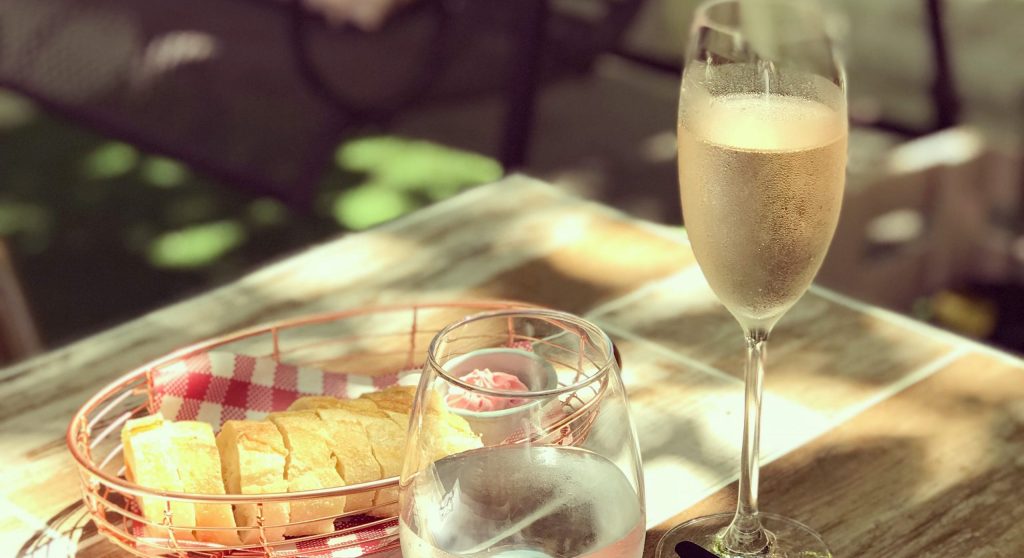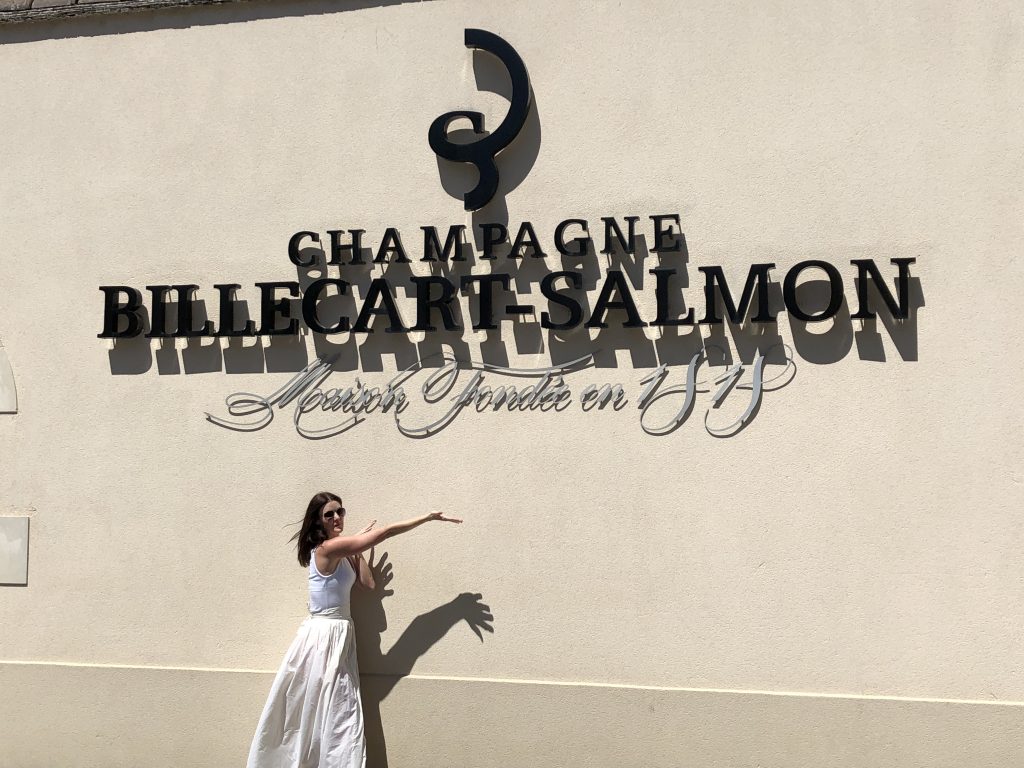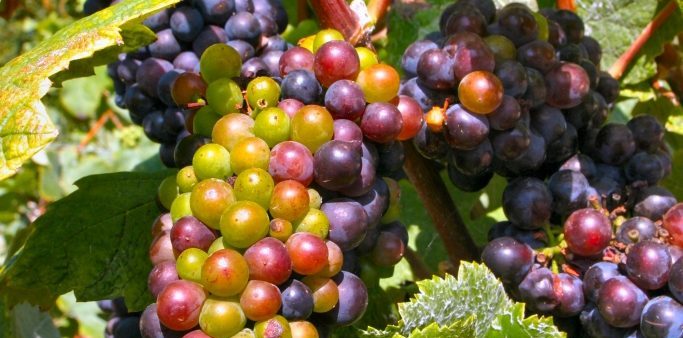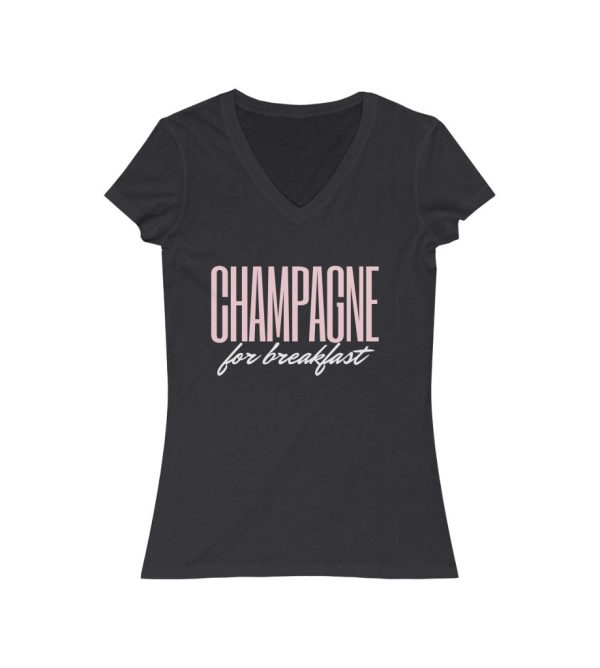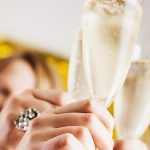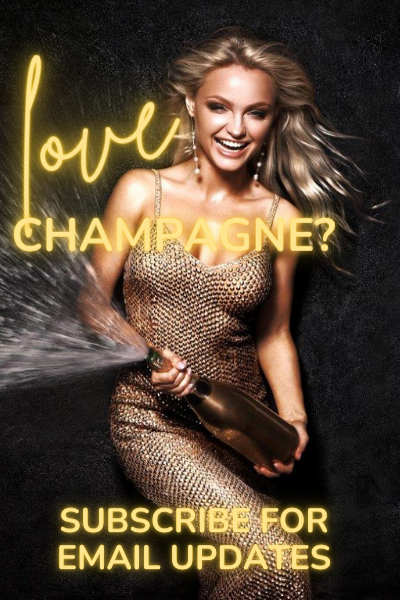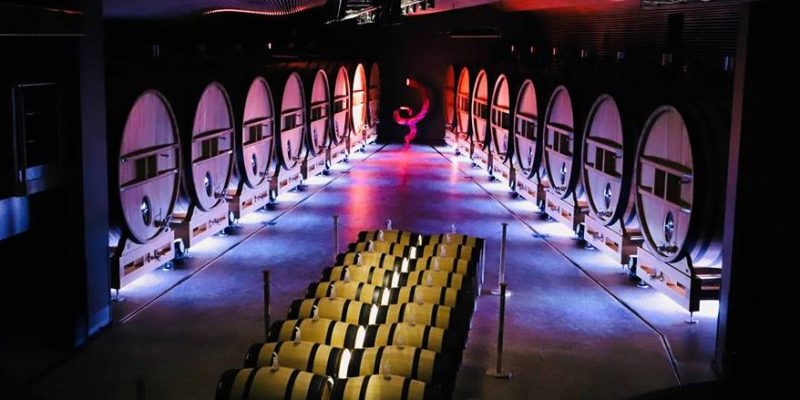
A Visit To Billecart-Salmon
- Marnie Nichols
- March 23, 2019
- A visit to..., Blog, Champagne Houses
In this post today, I will take you through my visit to Billecart-Salmon step-by-step, from the start in the vineyards, through the cellars and into the tasting room!
I want to start by thanking Jérôme and the family for welcoming me at their house… not once but twice. And I hope it is not the last time I visit… I have more to taste with you yet!
I wrote about this last in my post Five things you may not know about Billecart-Salmon (check it out if you missed it). What I love about Billecart-Salmon is that for a big(gish) name/brand, they have the heart of a family business. Yes, you can find the wines in the big wine retailers alongside some other much bigger names but the profile belies a philosophy of family, quality and community.
And this comes across immediately in a visit to the house.
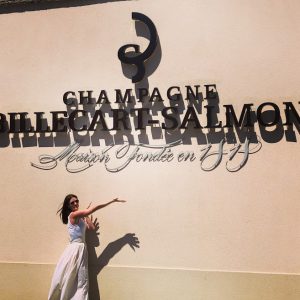
The main wall outside Champagne Billecart-Salmon

The original family house at Champagne Billecart-Salmon

My visit to Billecart-Salmon…
Started in the Clos Saint Hilaire.
This almost felt like starting at the end because the Clos Saint Hilaire is one of Billecart-Salmon’s most famous plots used to makes its most famous cuvées. The Clos Saint Hilaire is the cuvée de prestige of the house and as we started our tour in the vines, I had hoped we would end with it in our tasting but Jérôme was quick to dash my hopes #nexttime #thirdtimelucky. They only ever produce between 3,600 – 7,500 bottles and it costs almost $1,ooo in Australia … if you can find it.
To explain the word clos… a clos is a vineyard which must be closed on at least three sides. The Clos Saint Hilaire is named after Saint Hilaire, the patron saint of the village, and represents just under one hectare of pinot noir grapes.
Billecart Salmon Clos Saint Hilaire
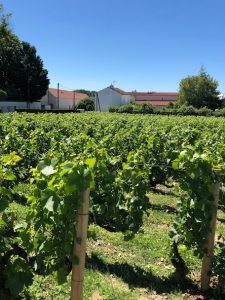
Jérôme explained that the Clos was planted in 1964 and the vines are 54 years old (in 2018), which is old for champagne.
“We would usually change the vines about every 30 years for a good yield. But in the Clos we are looking for very high quality wines so we keep them for longer. They produce fewer grapes but you have a better concentration and maturity which is the goal for the prestige champagne.”
Wine-making at Billecart-Salmon
I will try not to bore you with too much wine-making detail, but there are a few elements that are important or interesting (to me anyway!) about the Billecart-Salmon style…
In all the Billecart-Salmon vineyards, they use only organic fertilizer – mainly horse and sheep dung. On my visit to Billecart-Salmon, Jérôme explained that Billecart-Salmon works organically on 15 hectares and the rest is done under strict controls, still using synthetic products but they are aiming to reduce that every year.
For everything that comes after harvesting the grapes, Billecart-Salmon is a thoroughly modern house. The press room is home to 2 x 8,000 kg presses and 1 x 4,000 kg horizontal pneumatic press. There are no hydraulic basket presses, which Jérôme explained is softer, more precise, and creates less oxidation. In between each press, Billecart-Salmon re-mixes the bunches of grapes by an automated process in its pneumatic presses by deflating the bladder so the press can spins on itself, and there’s no need to open the press which causes oxidation. (Using a basket press, it is all done by hand with more oxidation… not right or wrong, just depends on the style of wine the house is looking to create.)
Billecart-Salmon quality standards mean they only use the first press in its champagnes (more about pressing here).
The first press is very gentle to extract the finest juice called the cuvée, the second is a little stronger and is called the taille. The taille is more tannic and can be slightly coloured if you are pressing pinot noir because you start exerting more pressure on the skin. And finally the third press is stronger still and is called the rébeche . You don’t actually use the rébeche to make champagne, instead it goes to the distillery to make Ratafia or Marc de Champagne.
Jérôme explained that at Billecart-Salmon, they use only the coeur de cuvée (literally means the heart of the cuvée) (excluding the first 10% because that juice effectively rinses and cleans the berries) and not taille because it is too bitter for their style. (I will tell you where they send the taille if you ask.. it is very interesting).
“By legislation from four tonnes of grapes we are allowed to extract 2,550 litres in total – 2,000 litres of the cuvee, 500 litres of the taille and 50 litres of the rébeche. At Billecart-Salmon, from four tonnes of grapes we use just 1800 litres to make our own wines. Which means it takes 1.5 KG of grapes to make just one bottle of champagne.”
Jérôme explains the regulations around volumes of juice you can extract at pressing and the Billecart-Salmon approach.
Fermentation at Billecart-Salmon
Billecart-Salmon pioneered the use of cold settling in the 1950s and still use the technique prior to fermentation today. It is the only house to use a double settling without adding any synthetic. The first cold settling is done at 8 degrees and the second at 4 degrees and all the sediment gathers together and, by gravity, sinks to the bottom of the vats. It is very natural and gentle and the double settling means there is nothing left in the wine that can change the taste of the wine later on.

Once the sediment is at the bottom, 10-12 % of production from the best plots the juice is put it into oak barrels to vinify (or undergo alcoholic fermentation) and the rest is vinified in stainless steel.
Jérôme explains again how Billecart-Salmon does things a little differently to produce its unique style.
“While traditional alcoholic fermentation is done at between 18-20 degrees, in the 1950s our CEO was looking for ways to bring a different style to his champagne. He knew someone brewing beer in the north of France using cold fermentation, so he applied the technique to champagne and found it was interesting and much gentler. So now all alcoholic fermentation at Billecart-Salmon is done at between 12 and 13 degrees.
Jérôme explains when the yeast eats the sugar and produces carbon dioxide in traditional alcoholic fermentation, the yeast is very lively. At colder temperatures, the yeast is a bit sleepy so it eats the yeast more slowly and the alcoholic fermentation is more progressive.
This gives the wine more fruitness, freshness, and elegance. It takes much longer – six weeks – but it is worth it and is part of what makes Billecart-Salmon special. We were the first to do it and still the only one.
Jérôme explaining again how Billecart-Salmon does things a little differently to produce its unique style.
After alcoholic fermentation, Billecart-Salmon will decide whether to allow malolactic fermentation to soften the acidity and brings complexity. Jérôme says by blocking it, you bring more leanness and freshness and the cellar master decides each year what they will do based on what is best for the wine.
Blending is a team effort!
Billecart-Salmon has a total of 450 stainless steel vats separated by plot each year that they can use for the blending.

For the non-vintages, they blend wines from three – four different years and every harvest, they keep a third of all wines for reserve wines.
This next discussion was actually one of my favourite parts of my visit to Billecart-Salmon (my fave was, of course, the tasting!).
Jérôme told us the blending is a team effort at Billecart-Salmon with a group of six winemakers involved… the cellar master and his assistant, the vineyard master, the CEO, his brother, and their father (the CEO who invented the cold settling in the 1950s… he is 94 and has been working with the wines for 70 years!)
Once the still wines are ready, the tasting group meets every morning at 11.30am and they have to taste all of them. Then they decide what to keep as reserve wines and what will be used in which wines. Then they prepare all the different blends and at the end of January/early February they meet again and decide if the blends are right.
Here’s the super-amazing part… they all have to agree. All six of them! And if they don’t all agree, they keep adjusting. Just for the Brut Reserve, they need about two months to finalise the blend. Once they all agree, they re-produce the blend and finish the process.
The final last parts of the process are stabilisation and filtration. Cold stabilisation at minus 5 degrees Celcius will crystalise the tartaric acid and then they filter the wine to get rid of all the dead yeast from the first fermentation.
Then the wine is ready to be bottled.
Oak barrels at Billecart-Salmon
I love visiting the barrel rooms at champagne houses, and on my visit to Billecart-Salmon I got to see their 400 oak barrels. These barrels are all second-hand because new barrels would be too tannic and too strong for the Billecart-Salmon style of champagne. All the barrels are used at least three times to make white burgundy before coming to Billecart-Salmon.
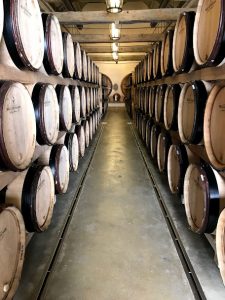

They vinify only the juices from the best plots in the barrels. Cold fermentation is done in the barrels, but never malolactic fermentation (it is blocked) and there is a short ageing in the barrels for only six months.
Wines in the barrels are mainly used for the vintage champagnes but since 2012 there is also a dedicated NV champagne vinified 100% in oak barrels – the Sous Bois.
All this technique is designed to achieve the effect Billecart-Salmon wants from the barrels. It differs for all houses and winemakers but according to Jérôme…
What we want from the barrels is the fine and elegant taste of oak – coffee, vanilla, mocha.
What Billecart-Salmon wants from the oak barrels
An exciting new direction in the cellars…
Billecart-Salmon has embarked on an exciting and daring project that will take decades to be realised. In the new chais at the House, they have introduced 24 barrels at Billecart-Salmon dedicated to the Clos Saint Hilaire.
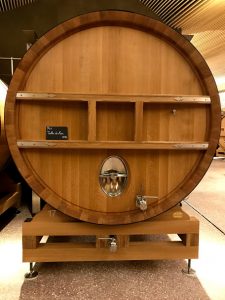
These casks were made by four different coopers, three are French from Burgundy and one is Austrian. It is a long-term project to get a wood that is good enough to make these kind of barrels…
you have to wait 200 years for the trees to be dense enough to be ready!
15 years ago, the cellar master went into the forest to choose the trees. The wood then had to dry for 10 years.. one year for every cm and the barrels are 10 cm thick).
And the room won’t be ready for another 15 years!
The room also holds a group of smaller barrels, that are all brand new.
Now remember that Billecart-Salmon doesn’t use new barrels, so they are ‘seasoning’ them for three-five years by making wine in them that they won’t use. The wine won’t go to waste, they sell it to other champagne houses…while it is not good enough for Billecart-Salmon, others houses can make use of it if their style is heavy and strong.
All of the barrels are individually temperature controlled. When I asked how, Jérôme wouldn’t tell us – it is a secret! But he did say the room was full of hidden technology and magnificent touches!
You might notice that the stoppers on the barrels look quite special… they are made from baccarat crystal.

The floor is in marble and granite from Italy polished for hours and hours to make sure there are no holes or flaws which can breed bacteria.
The air in the room is filtered continuously, temperature and humidity controlled, and the water they use to clean the barrels is filtered.
It did feel really special in the room that was launched as part of the bicentennial celebrations… I can’t wait to make a visit to Billecart-Salmon in 15 years and try the wines from the barrels!

The tasting on my visit to Billecart-Salmon
In the final part of my visit to Billecart-Salmon, we wandered through the cellars and finished with the….
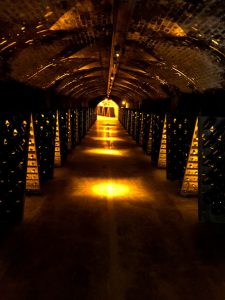


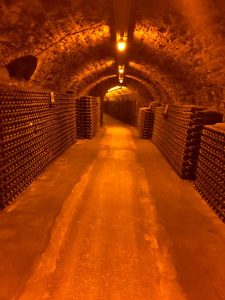
TASTING!
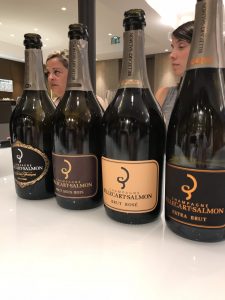
Billecart-Salmon offers 11 champagnes, six NVs and five vintages.
During my visit to Billecart-Salmon in 2018 we tried four (below) and in 2015 I tried three. The only champagne I had both times was the Brut Rose, which is the hero of the house.
There are links to more info about the tasting notes below.
You can visit too!
Billecart-Salmon welcomes guests. You can make an appointment for a visit to Billecart-Salmon here.
But because not everyone will get to visit the house, I hope you enjoyed reading about my rendezvous with Billecart-Salmon. Please take my experience to your next tasting of one of their champagnes, and see if it doesn’t taste a little different for knowing a few more things about the family and history behind the champagnes.
Have you been to Billecart-Salmon? Tell me about your visit and if you go in the future, make sure you post a pic and tag @bubbleandflute #bubbleandflute #happychamper #champagnefan
My Top Five Special Occasion Champagnes
My Top Five Spring Rosé Champagnes
Five Things You May Not Know About Billecart-Salmon
Champagne Grapes… Pinot Meunier
Bubble & Flute promotes the responsible consumption of alcohol for individuals of legal drinking age in their country.

